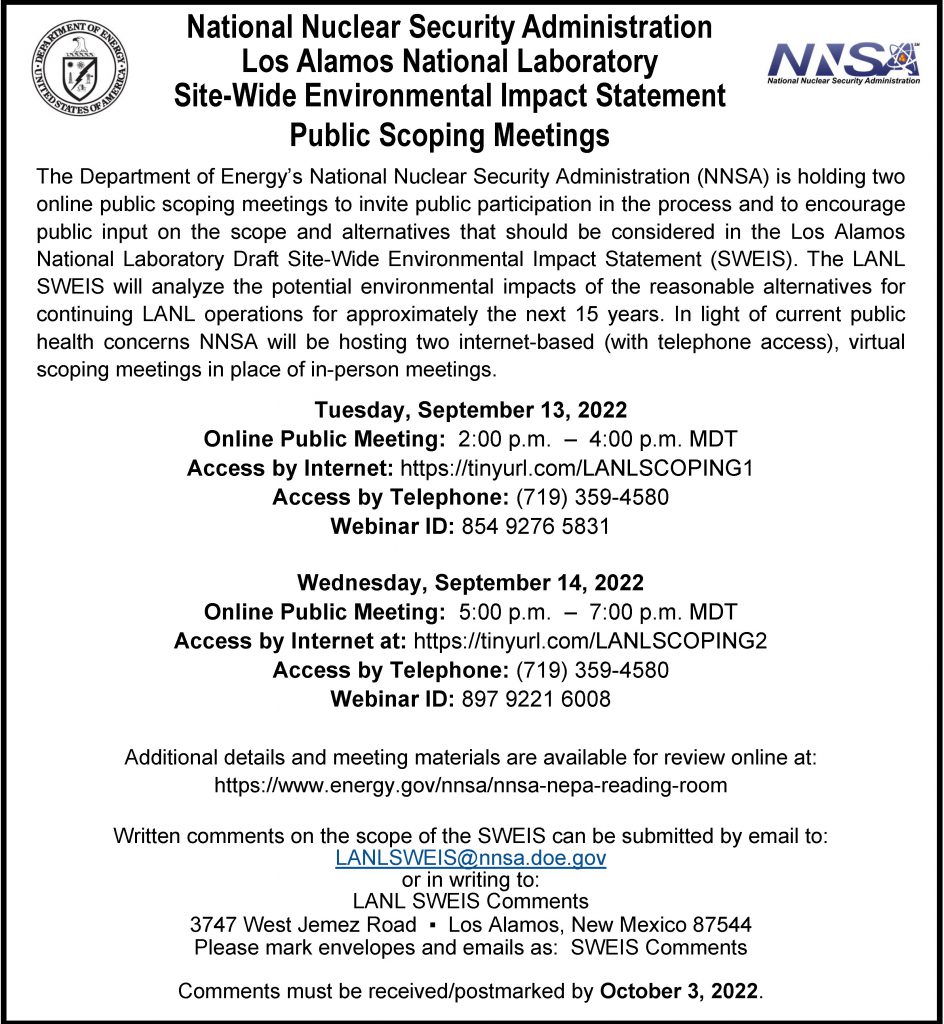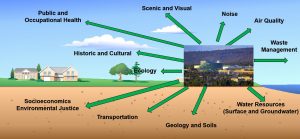The Department of Energy (DOE) will hold two virtual scoping meeting that will be accessible online and by telephone. At these virtual meetings the public is invited to learn about the scoping process and how the public may provide comments on the DOE’s proposed activities and any alternatives to them.
The first meeting is set for Tuesday, September 13th from 2 to 4 pm Mountain Daylight Time.
Access by Internet at: https://tinyurl.com/LANLSCOPING1
Access by Telephone: (719) 359-4580
Webinar ID: 854 9276 5831
The second meeting is set for Wednesday, September 14th from 5 to 7 pm Mountain Daylight Time.
Access by Internet at: https://tinyurl.com/LANLSCOPING2
Access by Telephone: (719) 359-4580
Webinar ID: 897 9221 6008
For more information, visit: https://www.energy.gov/nnsa/nnsa-nepa-reading-room
View our New “Guide to LANL SWEIS ‘Scoping'” Here:
 DOE identified 21 preliminary environmental issues that they plan to analyze in the study. DOE explained in the August 19, 2022 Federal Register notice:
DOE identified 21 preliminary environmental issues that they plan to analyze in the study. DOE explained in the August 19, 2022 Federal Register notice:
The following issues have been identified for analysis in the SWEIS. The list is tentative and intended to facilitate public comment on the scope of the SWEIS. It is not intended to be all inclusive, nor does it imply any predetermination of potential impacts. The NNSA specifically invites
suggestions for the addition or deletion of items on this list. [Emphasis added.]
- Potential effects on the public and workers from exposures to radiological and hazardous materials during normal operations, construction, reasonably foreseeable accidents (including from natural phenomena hazards), and intentional destructive acts
- Impacts on surface and groundwater, floodplains and wetlands, and on water use and quality
- Impacts on air quality from potential releases of radiological and nonradiological pollutants and greenhouse gases
- Impacts to plants and animals and their habitats, including species that are federally or state-listed as threatened or endangered, or of special concern
- Impacts on physiography, topography, geology, and soil characteristics
- Impacts to cultural resources, such as those that are historic, prehistoric, archaeological, scientific, or paleontological
- Socioeconomic impacts to affected communities
- Environmental justice impacts, particularly whether or not activities at the Laboratory have a disproportionately high and adverse effect on minority and/or low-income populations
- Potential impacts on land use and applicable plans and policies
- Impacts from traffic and transportation of radiological and hazardous materials and waste on and off the Laboratory campus
- Pollution prevention and materials, and waste management practices and activities
- Impacts on visual aesthetics and noise levels of Laboratory facilities on the surrounding communities and ambient environment
- Impacts to community services, including fire protection, police protection, schools, and solid waste disposal to landfills
- Impacts from the use of utilities, including water and electricity consumption, fuel use, sewer discharges, and resource conservation
- Impacts from site contamination and remediation
- Unavoidable adverse impacts

- Environmental compliance and inadvertent releases
- Short-term uses and long-term productivity
- Irreversible and irretrievable commitment of resources
- Cumulative effects of past, present, and reasonably foreseeable future actions
- Mitigation commitments
https://www.energy.gov/sites/default/files/2022-08/noi-eis-0552-lanl-site-wide-2022-08.pdf
In response the groups and individuals declared DOE’s list, “barely scratches the surface of issues that need to be analyzed” and created their own list. They wrote:
Here are examples of other issues that must be included:
- The slow pace of cleanup, which prompted the NMED to sue DOE to terminate a 2016 Consent Order that governs environmental remediation at LANL.
- Truly comprehensive cleanup that will permanently protect precious water resources instead of the “cap and cover” that LANL proposes, leaving some 200,000 cubic yards of radioactive and toxic wastes buried in unlined pits, shafts and trenches.
- The growing threat of wildfires caused by climate change, including the May 2022 Cerro Pelado fire, which unfortunately New Mexico is growing all too familiar with.
- LANL’s chronic track record of nuclear safety inc In the past this forced a three-year suspension of major operations at LANL’s main plutonium facility, now the site for expanded plutonium pit production.
- Yet more generation of plutonium contaminated radioactive wastes that NNSA believes it may dispose of in the already oversubscribed WIPP.

- Environmental and social justice impacts on frontline communities, recognizing that New Mexico is a majority minority state. DOE plans to spend $9.4 billion in FY 2023 in New Mexico (71% for core nuclear weapons research and production programs), substantially greater than the state’s entire budget of $8.5 billion. The inequitable economic impacts of such funding must be thoroughly evaluated.
- Massive construction projects due to expanded pit production plans, including new power lines and a bridge across the Rio Grande.
- Seismic impacts must be updated.
LANL SWEIS 2022 Scoping Extension Request 8-25-22
Many changes have occurred at LANL since 2008, including the proposals to increase the production of plutonium pits, or the triggers, for nuclear weapons, from 20 to 30 per year – a 50 percent increase. This means that if the proposed expansion of production goes into effect, there will be 50 percent more radioactive and hazardous waste will be generated, more water will be used, and more emissions into the air.
